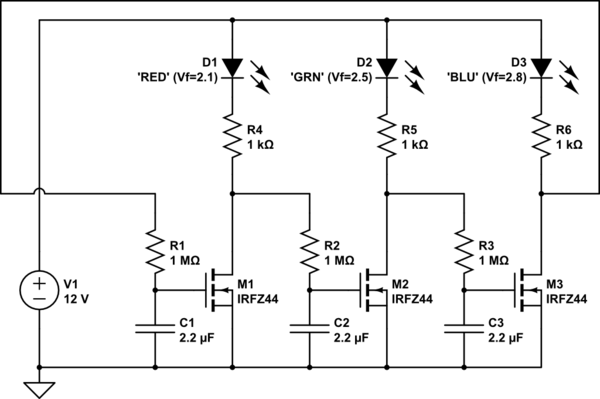If you understand how an astable multivibrator works, you can get to see how this one works, except that instead of going back and forth it actually goes "in a circle".
First of all, there should be a resistor between each LED and the drain of its MOSFET, while the 1M resistor would remain connected directly to the drain (I've drawn the circuit below with such resistors so that you can understand how your circuit works).
This "oscillator" actually goes from one MOSFET/LED to the next, in a circle.

simulate this circuit – Schematic created using CircuitLab
Let's say Q1 is turned on. Its drain is grounded, which keeps the Q2 gate grounded and thus Q2 is in OFF state.
Since Q2 is off (not conducting), its drain is high, which charges the capacitor on the gate of Q3 through the 1M resistor (Q3 is off at this moment, keeping its drain high and thus Q1 gate high and Q1 on).
Once the capacitor voltage on the gate of Q3 reaches high enough level, Q3 turns on, its drain goes low (to ground), and it slowly discharges the capacitor on Q1 until it turns it off.
Once the Q1 turns off, its drain goes high and charges up the Q2 gate capacitor until Q2 turns on, which in turn brings Q2 drain low and slowly discharges Q3 gate capacitor until Q3 turns off, and so on in a circle.
From what I understand, 2 LEDs will be on at a time.
In order for this whole circle to start, one of the transistors (due to slight inequalities or component tolerances) will reach the ON state sooner than the others and the others will follow it. For the first 1 or 2 cycles, it may happen that all LEDs are off, or some other irregularity, but that should soon be set in a proper "motion" after the first couple cycles.





